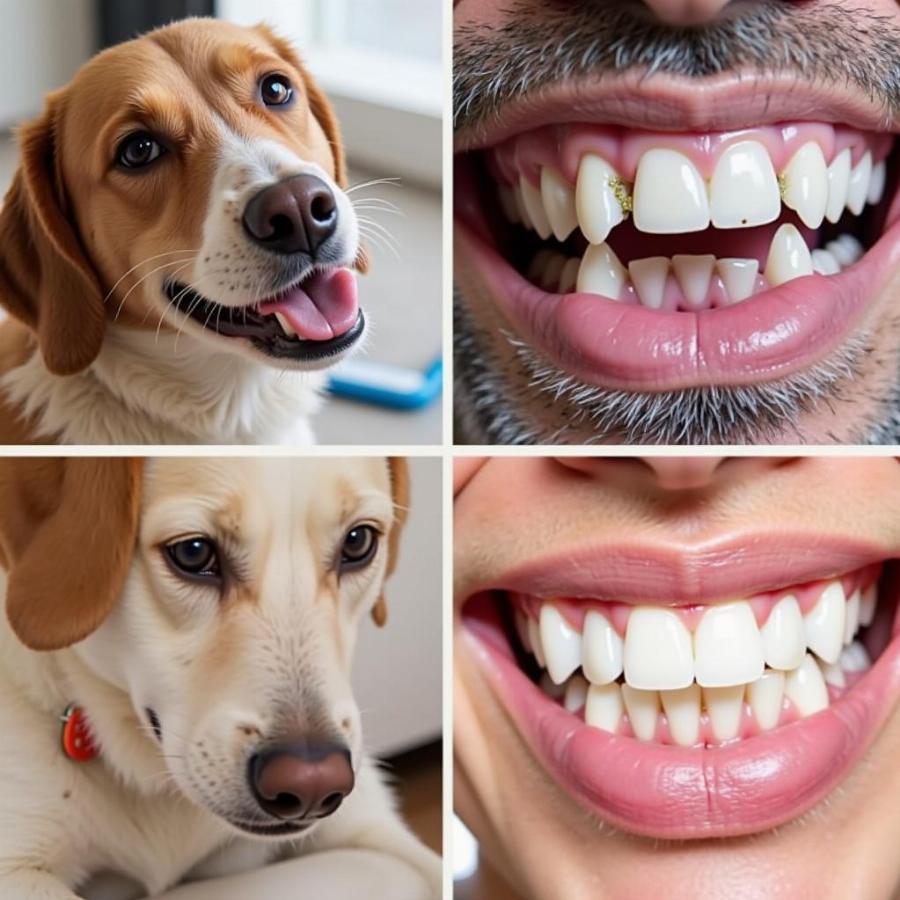Dog tartar, that unsightly brown buildup on your furry friend’s teeth, isn’t just an aesthetic issue. It’s a sign of poor oral hygiene and can lead to serious health problems down the road. Knowing how to soften dog tartar can make at-home dental care easier and more effective, ultimately contributing to your dog’s overall well-being. This article will guide you through safe and effective methods for softening dog tartar, helping you keep your dog’s pearly whites sparkling and their breath fresh.
Understanding Dog Tartar Formation and its Implications
Before diving into how to soften dog tartar, it’s essential to understand how it forms in the first place. Plaque, a sticky film of bacteria, constantly forms on your dog’s teeth. If not removed regularly through brushing, this plaque hardens into tartar, also known as calculus. Tartar can irritate the gums, leading to gingivitis, and eventually periodontitis, a severe infection that can damage the supporting structures of the teeth and even affect other organs.
Effective Methods for Softening Dog Tartar at Home
Several methods can help soften dog tartar at home, making it easier to remove. These methods work best when combined with regular brushing and professional dental cleanings.
Dietary Changes for Tartar Control
Certain dog foods and treats are specifically designed to help scrape away plaque and prevent tartar buildup. Look for kibble with a larger, textured surface, and consider incorporating dental chews like antler dog chew into your dog’s routine.
Using Tartar-Softening Products
Several products are available that can help soften dog tartar, including enzymatic toothpaste, gels, and water additives. These products contain enzymes that break down the plaque and tartar matrix, making them easier to remove.
Home Remedies for Softening Tartar
While not as effective as professional products, some home remedies may offer some benefit. Adding a small amount of coconut oil to your dog’s food is thought to have some plaque-reducing properties. Similarly, some people believe that apple cider vinegar diluted in water can help soften tartar. However, always consult your veterinarian before using any home remedies.
 Dog Tartar Before and After Treatment
Dog Tartar Before and After Treatment
Professional Dental Cleaning: When Home Care Isn’t Enough
While home care is crucial, professional dental cleaning is the most effective way to remove hardened tartar and address any underlying gum disease. During a professional cleaning, your dog is placed under general anesthesia, allowing the veterinarian to thoroughly clean the teeth above and below the gum line.
How Often Should My Dog Get a Professional Cleaning?
The frequency of professional cleanings depends on your dog’s breed, age, and overall oral health. Many dogs benefit from annual cleanings, while some may require them more or less frequently.
Preventing Tartar Buildup: A Proactive Approach
The best way to deal with dog tartar is to prevent it from forming in the first place. Regular brushing, along with the use of dental chews, like yak bones for dogs, and a healthy diet, can significantly reduce the accumulation of plaque and tartar.
Choosing the Right Dental Tools for Your Dog
Using the right tools is crucial for effective brushing. Choose a toothbrush designed specifically for dogs, and consider a finger brush for easier access to hard-to-reach areas. Enzymatic toothpaste is also recommended.
What if My Dog Refuses to Let Me Brush Their Teeth?
Many dogs initially resist having their teeth brushed. Start by getting them used to having their mouths touched, and gradually introduce the toothbrush. Positive reinforcement with treats and praise can make the process more enjoyable for both of you. You can also explore alternatives like dental bone for dogs
Is Chewing Enough to Keep My Dog’s Teeth Clean?
While chewing can help, it’s rarely enough on its own to prevent tartar buildup completely. It’s still important to brush your dog’s teeth regularly. However, offering appropriate chews, like those discussed, can play a significant supportive role in maintaining good oral hygiene. It’s important to select safe and digestible chews, and avoid options like is beef hide bad for dogs which can pose choking hazards. Alternatives like is pig ears good for dogs are good options.
Conclusion
Learning how to soften dog tartar is an essential part of responsible dog ownership. By incorporating regular brushing, dental chews, and professional cleanings into your dog’s routine, you can help prevent tartar buildup and ensure their long-term oral health. Remember, a healthy mouth contributes to a happy and healthy dog!
FAQ
- What is the difference between plaque and tartar?
- Can I use human toothpaste on my dog?
- What are the signs of dental disease in dogs?
- How can I get my dog used to having their teeth brushed?
- Are there any risks associated with anesthesia for dental cleaning?
- How much does a professional dog dental cleaning cost?
- Can dog tartar be removed without anesthesia?
Further Reading
- Dog Dental Care Guide
- Understanding Canine Dental Disease
Beaut Dogs is your go-to resource for all things related to dog care, offering expert advice and valuable information on a wide range of topics, from breed-specific needs to health and nutrition. When you need support, reach out to us via Email at [email protected] to receive detailed and accurate answers from Beaut Dogs. Visit us at https://beautdogs.com to learn more.